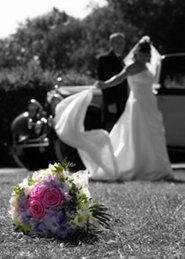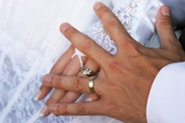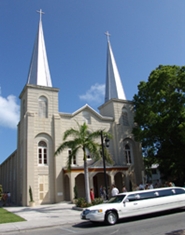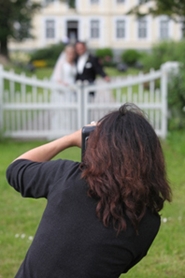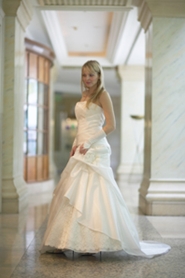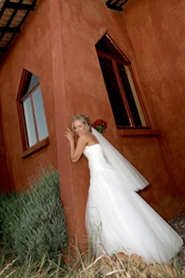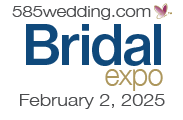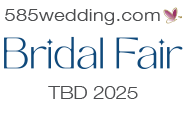Rochester Wedding Photographers
Your Rochester professional photographer can provide you with the wedding pictures you will have for a lifetime.
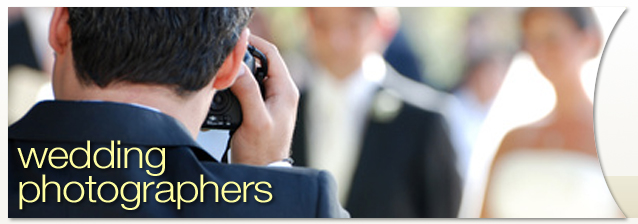
Rochester Wedding Photographers
Your wedding day will be filled with special moments to cherish forever. A Rochester area professional photographer can provide you with the pictures you will have for a lifetime.
After the cake is eaten, the flowers wilt, and the memory of the day begins to blur into hazy shadows, the lasting reminder of your wedding day will be in photos. Shopping for a wedding photographer is different than shopping for a gown, invitations or reception hall. You try on the gown, visit the reception site, and make very precise decisions about your invitation. Photography is not so simple. You won’t see what you have purchased until after the wedding.
Hire A Professional
Good professional photographers will do the best job of capturing the different emotions of the day. They know when and where to be at all times during the ceremony. They know how to set up their equipment and lighting in the most effective and efficient ways. It is advised that you start your search well in advance. The best photographers can be booked as far ahead as a year, especially during peak wedding months.
Cost
Price is usually the one obstacle that prevents many wedding clients from selecting the photographer who undoubtedly could give them the best value for the money. It makes sense to evaluate the money spent on photographs in relation to what’s being spent on the reception hall, flowers, food and music. Many people still choose to “shop for bargains†on the photography. Don’t forget: you will be sharing your memories with others through the eyes, heart and talent of your photographer. Regardless of the deal you get, if you are unhappy with the results, it wasn’t worth it. Make sure to compare both quality and price. Make sure you know exactly what is included. What is the photographer’s payment policy? Does it seem fair, and can you manage it within your budget?
The First Step: Begin with a phone call or email. Many photographers now have websites. Take a look first. In addition to the photographer’s availability, ask about the studio’s philosophy and approach toward wedding photography. Is there an emphasis on posed or unposed images? If they do both, what proportion is posed, and how much is unposed? Find out the name of the photographer who will be photographing. Get information on costs, and if you are interested in learning more, set up an appointment to see work and discuss the details.
Meet with the photographer: Do you feel comfortable with him or her? Will you enjoy having this person around on one of the most important days of your life? Look at as many examples of work as possible. If you are speaking to a studio that has more than one photographer, ask who took the photos you are looking at. You may be shown an album of photos that are highlights from various weddings. If you like these, ask if you can see an album from one couple’s wedding. Even better? Ask if you can see a proof book from one couple’s wedding. See if the photographer captures the excitement and emotion of the wedding day. Do the photos show creativity, or does every album look the same? Do the subjects look at ease with the photographer? Ask yourself how this photographer will make your wedding photographs both unique and personal.
Ask how many years the photographer has been photographing weddings, as well as how many weddings a year he or she books. What kind of educational background, and/or experience does the photographer have? What equipment will be used, and will there be plenty of back up equipment? Will there be an assistant to help out? An assistant will help the photographer work more quickly and efficiently, as well as relieve the level of stress that photographic aerobics at weddings often entail. At higher price levels, you may even find studios that send two photographers to shoot different aspects of the day. What happens if the photographer is sick or has a family emergency? Are there back up plans? It is also wise to ask for references.
Styles and Trends
This is an exciting time for wedding photography. The options have never been greater. A couple should look at examples of the type of work that is being done. In addition to the classic style of traditional wedding photography, couples will also find photographers taking a photojournalistic approach, others whose work is more fashion oriented and still others who combine looks.
Traditional wedding photography: An emphasis is placed on formal poses and staged candids. The photographer should be well versed in lighting and posing techniques, and should be able to analyze a person’s physical attributes and pose that person in a way that is flattering. Special effects are sometimes an option. The traditional photographer often will work from a check list of shots that are selected by the couple. Staged candids are taken of events such as the cake cutting and bridal dance. For these shots, the couple is usually asked by the photographer to stand in a particular way. It is very important that you feel comfortable if you are hoping for natural looking results.
Wedding photojournalism: More akin to newspaper or magazine photography than studio portraiture, moments are captured as they unfold. The photojournalist will not interfere with the flow of events, so you won’t be asked to interrupt your activities to pose for another photo. A good photojournalist should be great at catching emotions, and have a quick and creative eye. Since lighting conditions at weddings and receptions vary greatly, the wedding photojournalist must be skilled at dealing with a variety of lighting situations. In order to be ready to “find†photos as they happen, it is also important that he or she be experienced with typical wedding and reception scenarios, and that your wedding details be thoroughly discussed.
Fashion: Some traditional photographers and wedding photojournalists are including photos that have more of a look of a fashion magazine. These photos look trendy, and may include techniques such as selective coloring, and cross processing.
Combining Styles
Many Rochester area photographers claim to do a combination of styles. Make sure that you view albums of their work. You will most likely see an emphasis on one or the other. Most photojournalists will do formals of the bride and groom and posed groups as requested. If you are interested in the photojournalistic approach, but want some posed shots, ask to see examples of posed photos, too. A photojournalist may take less time on the posed shots than a traditionalist. The poses may be looser. However, they should still show knowledge of lighting requirements and techniques
Do you like the way the posed photos look? Can you imagine yourself posing in these photos? Many traditional photographers will shoot some unposed candids at the reception, or will mix both styles throughout the day. If a traditional photographer offers this option, make sure that you see sufficient examples of this in the sample albums you view. Look for candids that have energy, show the spirit of the event, and are artistically composed. Some traditional photographers may say they do photojournalistic photos in order to make a sale, but if their heart isn’t in it, the results may be disappointing.
Album design: There are many new choices in album designs. Take a look and see what’s around. In additional to the traditional albums where your photos are placed under mats or inside mats, photographers are now making magazine style collage albums. Each page consists of one photo or a montage of photos. It is either printed on photographic paper and flush mounted into the album, or printed directly onto pages that are bound into a book. Other options include scrapbook style albums, or elegant portfolio boxes of matted prints.
The Photographer’s Equipment
Lighting: Find out what type of lighting and camera equipment the photographer uses. Some photographers will light indoor formals using a single flash mounted on top of the camera, a technique that is fast and simple. Others will add a portable studio light or two in order to approximate studio lighting. Some photographers will also add extra portable flash units in the background at the reception rather than rely only on an on-camera flash.
Digital: Digital is revolutionizing the photographic industry. You will find that some photographers are now photographing some or all of their weddings with digital cameras. Because most couples are only familiar with point and shoot digital quality, they are concerned that the quality of wedding photos will suffer from this change. If done skillfully and with professional DSLR cameras, the quality is comparable. Most photographers who are shooting weddings with digital equipment should have examples of photos shot on film. Ask to see both and compare. There are definite advantages to digital. The photographer gets immediate feedback from the camera, and therefore is alert to any technical or aesthetic concerns.
Because there is no film and processing costs, the photographer is able to shoot more. Because there is immediate feedback from the camera, it is easier to shoot available light, and to experiment with new ideas. Photos can be easily converted to black and white, and other affects such as selective coloring or sepia toning can be introduced. Digital also makes is easier for photographers to post a couple’s photos on the Internet, so they can share them with friends and family.
One of the great things about digital photography is the immediacy of it as a medium. One of the fun things more and more photographers are doing is taking a computer to the reception, uploading shots taken earlier in the day and letting them rotate as a slideshow during the evening. If your photographer is able to do this, it will add a fun element to the festivities.
If you are considering a photographer who shoots digitally, you should ask how long he or she has been using digital equipment. There is a learning curve to digital, and it is important that your photographer has had enough experience to work the bugs out. Make sure you see examples of their digital prints. Most labs these days are digital labs. Prints for your album should be printed with the best possible equipment, on the best possible paper. This will ensure that your prints will last as long as prints made from film.
Film: Wedding photographers use two different film formats. Each has its advantages, and there are good reasons to use both. Cameras which use 120 or 220 film are referred to as “medium format†cameras, and have long been the standard for wedding photographers. Prints from these negatives can be enlarged to 11X14†or larger without losing sharpness or showing much grain.
With the current market of excellent 35mm professional films, and sophisticated cameras with extremely sharp lenses, most people will find it difficult to see any difference in quality between 35mm and the mediums format films in enlargements up to 8X10â€. 35mm is particularly useful for the wedding photojournalist because of it’s fast lenses which allow for shooting in low light, and because of its quickness of operation which makes it more versatile when taking spontaneous, unposed photos.
Pricing Methods
Many photographers will offer you a choice of packages. Each package will include the photographer’s services for a specific amount of time, as well as a predetermined number of photos, a bridal album, parent albums, and perhaps some other goodies thrown in. Add-ons for additional fees are welcomed and encouraged by the photographers, who make much of their wedding income on print orders. Other photographers operate on an ala carte method. You choose from a menu of options and come up with your own plan. Some photographers will be willing to give or sell you your negatives or digital files. Others won’t. If you are able to work with a photographer who gives you your negatives, use that photographer’s lab, if possible, to make your prints You will find that sorting, organizing and preparing negatives or digital files to deliver to a printer is a big job, and you will most likely come to appreciate the work that others pay photographers to do for them. Photographers and printers are partners, both responsible for the quality of your final product. A poor print of a great negative or digital file will be a big disappointment and will not do justice to your wedding or your photographer’s skills.
Communicate!
Communication with your photographer can make all the difference. Whether traditional or photojournalistic, you and your photographer should prepare a written scenario of the day with your expectations included. You should include any special requests and any other information that will help the photographer do his or her job well.
It is important that you talk with your photographer about scheduling the day around the time needed to take formal photos. One of the largest complaints that people voice about their wedding photography is that it took them away from their guests for too long. A skilled photographer can help you plan time for formals so that they won’t detract from your enjoyment of the day.
Make sure that you have spoken to the person performing the ceremony about rules for taking photographs. Flash may be allowed or prohibited. Some officials will permit the photographer up near the altar. Others will insist that he or she stand in the back of the ceremony site. Still others may not allow photography at all during the ceremony.
Create a shot list! One of the most helpful tips about wedding photography is to think ahead about the shots that you would like to have captured and compile a list so that your photographer can check them off. Be sure to include special people or shots you want, such as out-of-town guests, college buddies, or extended family groups. It may be easiest to appoint a relative who is not a member of the wedding party to help the photographer identify guests and family members. This is particularly helpful in the family shots. There’s nothing worse than getting back your photos and realizing you didn’t get a picture with grandma! Don’t forget to tell the photographer about delicate situations, such as a recently deceased grandparent, divorced parents, etc.
Scout the Location
Consider a Rochester area photography location for photos to be taken after the ceremony before arriving at the reception site. There are many beautiful photography locations in the Rochester area, browse through 585wedding.com’s suggested locations if you don’t already have a location in mind. Visit the locations of the different places that you’ll be having your photographer shoot before the big day. Ask your photographer if he or she might be willing to accompany you – it can be really helpful to know where you’re going, have an idea of a few positions for shots and to know how the light might come into play. If your photogrpher is willing, they may even take a few test shots (these can make nice engagement photos).
Table Cameras
Disposable table cameras are popular at weddings these days. They may be useful if you are using a limited amount of services from your professional photographer. The results can be fun and lively, or disappointing, depending on how the guests use the cameras. You might consider the price of these cameras and the expense of processing later, and decide whether your money might be better spent paying for more or higher quality professional photography.
Future Upcoming
Rochester Bridal Shows
![]()
![]()
Click here for your free tickets
![]()
Click here for your free tickets
![]()
Presented by

Rochester's wedding planning site!
![]()



